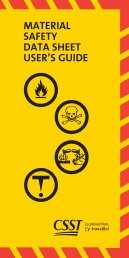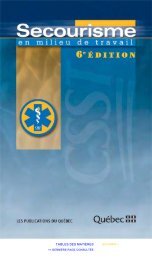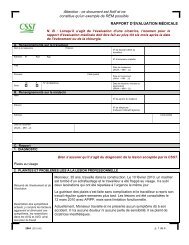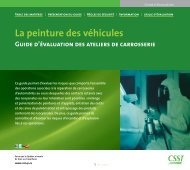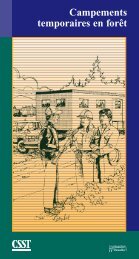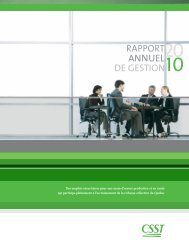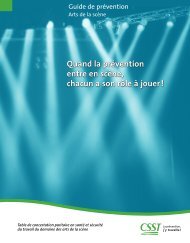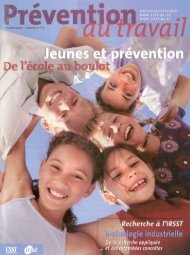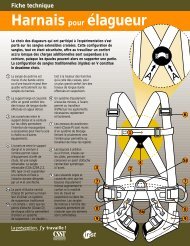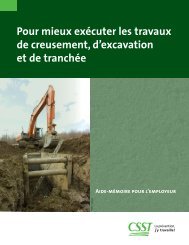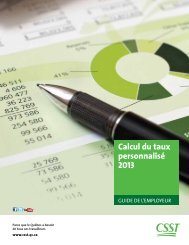Download PDF (619 ko )FSST and CSST Financial Statements 2007
Download PDF (619 ko )FSST and CSST Financial Statements 2007
Download PDF (619 ko )FSST and CSST Financial Statements 2007
Create successful ePaper yourself
Turn your PDF publications into a flip-book with our unique Google optimized e-Paper software.
c) Intangible assets<br />
Intangible assets are presented at their original cost <strong>and</strong> depreciated in proportion to their estimated<br />
useful life, according to the straight-line depreciation method, at the following annual rates:<br />
Software 20%<br />
Computer systems development 20%<br />
d) Impairment of Assets<br />
Tangible assets are regularly examined by management to determine whether their value incurred a<br />
loss when events or changing circumstances suggest that their carrying value might not be recoverable.<br />
Impairment is assessed by comparing the carrying value of an asset with undiscounted future<br />
cash flows estimated at use <strong>and</strong> with its residual value. If the value of the assets is considered<br />
impaired, the impairment is allocated to the results for the period during which it is determined.<br />
The impairment represents the difference between the carrying value <strong>and</strong> the fair value of the asset.<br />
The estimate of future cash flows is a matter of professional judgement <strong>and</strong> may vary over time.<br />
e) Pension plans<br />
The accounting method used for defined contribution pension plans is applied to government<br />
inter-enterprise defined benefit plans, since the <strong>CSST</strong> does not have enough information to apply<br />
the accounting method for defined benefit plans.<br />
f) Future accounting policy changes<br />
During the next fiscal year, the <strong>CSST</strong> will apply the new recommendations of the Canadian Institute<br />
of Chartered Accountants (CICA) with respect to the following sections:<br />
<strong>CSST</strong> <strong>Financial</strong> <strong>Statements</strong><br />
3862 – <strong>Financial</strong> Instruments – Disclosure<br />
3863 – <strong>Financial</strong> Instruments – Presentation<br />
The aim of these sections is to provide users with information that allows them to assess the<br />
significance of financial instruments for the entity’s financial position <strong>and</strong> performance. They also<br />
allow users to assess the nature <strong>and</strong> extent of risks arising from financial instruments to which<br />
the entity is exposed <strong>and</strong> the way it manages these risks. These sections replace CICA H<strong>and</strong>book<br />
Section 3861, <strong>Financial</strong> Instruments – Disclosure <strong>and</strong> Presentation. Disclosure requirements are<br />
revised <strong>and</strong> enhanced, while presentation requirements remain essentially unchanged. These sections<br />
specifically target disclosure <strong>and</strong> will have no impact on the <strong>CSST</strong>’s income.<br />
3. Accounting Change<br />
As of the current fiscal year, the <strong>CSST</strong> is applying the new Canadian Institute of Chartered Accountants<br />
recommendations relating to the recognition, measurement <strong>and</strong> presentation of financial instruments,<br />
in advance, retrospectively <strong>and</strong> without restatement of prior periods, further to the publication of<br />
Section 1530 – Comprehensive Income, Section 3855, <strong>Financial</strong> Instruments – Recognition <strong>and</strong><br />
Measurement, Section 3861 – <strong>Financial</strong> Instruments – Disclosure <strong>and</strong> Presentation <strong>and</strong>, lastly,<br />
Section 3865 – Hedges. For the <strong>CSST</strong>, the impact of these new accounting policies is limited solely<br />
to the disclosure of additional information, given that the categories adopted by the <strong>CSST</strong> had no<br />
impact on the measurement of financial instruments. These categories are explained in Note 2 a).<br />
45



